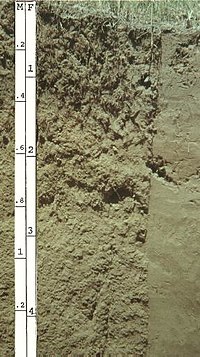Entisol
| Entisol | |
|---|---|
 Entisol profile showing little or no evidence of pedogenic horizon development |
In USDA soil taxonomy, entisols are defined as soils that do not show any profile development other than an A horizon. An entisol has no diagnostic horizons, and most are basically unaltered from their parent material, which can be unconsolidated sediment or rock. Entisols are the second most abundant soil order (after inceptisols), occupying about 16% of the global ice-free land area.
In Australia, most entisols are known as rudosols or tenosols, whilst arents are known as anthroposols. In the FAO soil classification, because of the diversity of their properties, suborders of entisols form individual soil orders (e.g. fluvisols, lithosols).
Causes of delayed or absent development
- Unweatherable parent materials - sand, iron oxide, aluminium oxide, kaolinite clay.
- Erosion - common on shoulder slopes; other kinds also important.
- Deposition - continuous, repeated deposition of new parent materials by flood as diluvium, aeolian processes which means by wind, slope processes as colluvium, mudflows, other means.
- Flooding or saturation.
- Cold climate - must not be sufficiently cold in winter for permafrost.
- Dry climate.
- Shallow to bedrock - may be rock resistant to weathering, such as quartzite or ironstone.
- Toxic parent materials - serpentine soil, mine spoils, sulfidic clays.
Suborders
- Aquents - permanently or usually wet soils formed on river banks, tidal mudflats etc. Here, general wetness limits development.
- Arents - anthropogenic soils: diagnostic horizons cannot develop because of deep mixing through plowing, spading, or other methods of moving by humans. In other soil classifications these are known as anthrosols.
- Fluvents - alluvial soils where development is prevented by repeated deposition of sediment in periodic floods. Found in valleys and deltas of rivers, especially those with high sediment load.
- Orthents - shallow or "skeletal soils". Found on recent erosional surfaces or very old landforms completely devoid of weatherable minerals.
- Psamments - entisols that are sandy in all layers where development is precluded by the impossibility of weathering the sand. Formed from shifting or glacial sand dunes.
Paleopedology
Most fossil soils before the development of terrestrial vegetation in the Silurian are entisols, showing no distinct soil horizons. Entisols have been abundant in the paleopedological record ever since then, though, unlike other soil orders (oxisols, ultisols, gelisols for instance) they do not have value as indicators of climate - though orthents might in some cases be indicated of an extremely old landscape with very little soil formation (as in Australia today).
See also
References
- "Entisols". USDA-NRCS. Retrieved 2006-05-14.[dead link]
- "Entisols". University of Florida. Retrieved 2006-05-14.[dead link]
- "Entisols". University of Idaho. Retrieved 2006-05-14.
